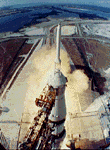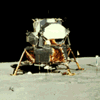|
| |

Apollo 11
 |
(L)
Neil A. Armstrong |
Commander |
| (C) Michael
Collins |
Command Module Pilot |
| (R) Buzz
Aldrin |
Lunar Module Pilot |
Crew Spaceflight Histories
| Neil A. Armstrong |
| |
Mission |
Dates |
Role |
Notes |
| |
Gemini VIII |
March 16, 1966 |
Command Pilot |
|
| |
Apollo 11 |
July 16-24, 1969 |
Commander |
1st man to walk on the
Moon. |
| Buzz Aldrin |
| |
Mission |
Dates |
Role |
Notes |
|
Gemini XII |
November 11-15, 1966 |
Pilot |
last Gemini mission |
| |
Apollo 11 |
July 16-24, 1969 |
Lunar Module Pilot |
2nd man to walk on the
Moon. |
| Michael Collins |
| |
Mission |
Dates |
Role |
Notes |
| |
Gemini X |
July 18-21, 1966 |
Pilot |
world atlitude record,
third U.S. spacewalker |
| |
Apollo 11 |
July 16-24,
1969 |
Command
Module Pilot |
|
Apollo 11 Backup crew:

The Apollo 11 spacecraft was launched
from Cape Kennedy at 13:32:00 UT on July 16, 1969. After 2 hr and 33 min in
Earth orbit, the S-IVB
engine was reignited for acceleration of the spacecraft to the velocity
required for Earth gravity escape.
Lunar-orbit insertion
began at 75:50 ground elapsed time (GET). The spacecraft was placed in an
elliptical orbit (61 by 169 nautical miles), inclined 1.25 degrees to the
lunar equatorial plane. At 80:12 GET, the service module propulsion system was
reignited, and the orbit was made nearly circular (66 by 54 nautical miles)
above the surface of the Moon. Each orbit took two hours. Photographs taken
from lunar orbit provided broad views for the study of regional lunar geology.
 The
lunar module (LM), with Astronauts Armstrong and Aldrin aboard, was undocked
from the command-service module (CSM) at 100:14 GET, following a thorough
check of all the LM systems. At 101:36 GET, the LM descent engine was fired
for approximately 29 seconds, and the descent to the lunar surface began. At
102:33 GET, the LM descent engine was started for the last time and burned
until touchdown on the lunar
surface. Eagle landed on the Moon 102 hr, 45 min and 40 sec after launch. The
lunar module (LM), with Astronauts Armstrong and Aldrin aboard, was undocked
from the command-service module (CSM) at 100:14 GET, following a thorough
check of all the LM systems. At 101:36 GET, the LM descent engine was fired
for approximately 29 seconds, and the descent to the lunar surface began. At
102:33 GET, the LM descent engine was started for the last time and burned
until touchdown on the lunar
surface. Eagle landed on the Moon 102 hr, 45 min and 40 sec after launch.
Immediately after landing on the Moon,
Armstrong and Aldrin prepared the LM for liftoff as a contingency measure.
Following the meal, a scheduled sleep period was postponed at the astronauts'
request, and the astronauts began preparations for descent to the lunar
surface.
 Astronaut
Armstrong emerged from the spacecraft first. While descending, he released the
Modularized Equipment Stowage Assembly (MESA) on which the surface television
camera was stowed, and the camera recorded humankind's first step on the Moon
at 109:24:19 GET (pictured at left). A sample of lunar surface material
was collected and stowed to assure that, if a contingency required an early
end to the planned surface activities, samples of lunar surface material would
be returned to Earth. Astronaut Aldrin subsequently descended to the lunar
surface. Astronaut
Armstrong emerged from the spacecraft first. While descending, he released the
Modularized Equipment Stowage Assembly (MESA) on which the surface television
camera was stowed, and the camera recorded humankind's first step on the Moon
at 109:24:19 GET (pictured at left). A sample of lunar surface material
was collected and stowed to assure that, if a contingency required an early
end to the planned surface activities, samples of lunar surface material would
be returned to Earth. Astronaut Aldrin subsequently descended to the lunar
surface.
 The
astronauts carried out the planned sequence of activities that included
deployment of a Solar Wind Composition (SWC) experiment, collection of a
larger sample of lunar material, panoramic photographs of the region near the
landing site and the lunar horizon, closeup photographs of in place lunar
surface material, deployment of a Laser-Ranging Retroreflector (LRRR) and a
Passive Seismic Experiment Package (PSEP), and collection of two core-tube
samples of the lunar surface. The
astronauts carried out the planned sequence of activities that included
deployment of a Solar Wind Composition (SWC) experiment, collection of a
larger sample of lunar material, panoramic photographs of the region near the
landing site and the lunar horizon, closeup photographs of in place lunar
surface material, deployment of a Laser-Ranging Retroreflector (LRRR) and a
Passive Seismic Experiment Package (PSEP), and collection of two core-tube
samples of the lunar surface.
 Approximately
two and a quarter hours after descending to the surface, the astronauts began
preparations to reenter the LM, after which the astronauts slept. The ascent
from the lunar surface began at 124:22 GET, 21 hours and 36 minutes after the
lunar landing. Approximately
two and a quarter hours after descending to the surface, the astronauts began
preparations to reenter the LM, after which the astronauts slept. The ascent
from the lunar surface began at 124:22 GET, 21 hours and 36 minutes after the
lunar landing.  In
transearth coast
only one of four planned midcourse corrections was required. The CM entered
the atmosphere of the Earth with a velocity of 36,194 feet per second (11,032
meters per second) and landed
in the Pacific Ocean. In
transearth coast
only one of four planned midcourse corrections was required. The CM entered
the atmosphere of the Earth with a velocity of 36,194 feet per second (11,032
meters per second) and landed
in the Pacific Ocean.
| Launch: |
July 16, 1969
13:32:00 UT (09:32 a.m. EDT) Kennedy Space Center Launch Complex 39A |
| Mission Duration: |
195 hr. 18 min. 35
sec. |
| Landing
Site: |
Mare
Tranquillitatis (Sea of Tranquility) 0.67 N, 23.47 E |
| Landed on Moon: |
July 20, 1969
20:17:40 UT (4:17:40 p.m. EDT) |
| EVA duration: |
2 hours, 31
minutes |
| Moon Rocks Collected: |
21.7 kilograms |
| LM Departed Moon: |
July 21, 1969
17:54:01 UT (1:54:01 p.m. EDT) |
| Returned to Earth: |
July 24, 1969
16:50:35 UT (12:50:35 p.m. EDT) |
| Time on Lunar
Surface: |
21 hours, 38
minutes, 21 seconds
|
| Mission Duration: |
195 hr. 18 min. 35
sec. |
| Retrieval site: |
Pacific Ocean 13°
19'N latitude and 169° 9'W longitude |
| Retrieval ship: |
U.S.S. Hornet |
Special
Payload:
- Plaque (commemorates
first manned landing)
-
Carried to Moon and returned two large
American flags, flags of the 50 states, District of Columbia and
U.S. Territories, flags of other nations and that of the United
Nations.
- MEPS (Modularized Equipment Stowage
Assembly) containing TV camera to record first steps on Moon and
EASEP (Early Apollo Science Equipment Package).
|
|
Highlights:
- First men on the Moon, Neil Armstrong and
Buzz Aldrin. First return of samples from another planetary body.
-
The prime mission objective of Apollo 11
is stated simply: "Perform a manned lunar landing and
return".
-
First return of samples from another
planetary body. These first samples were basalts, dark-colored
igneous rocks, and they were about 3.7 billion years old.
-
Plaque affixed to the leg of
the lunar landing vehicle signed by President Nixon, Neil A.
Armstrong, Michael Collins and Edwin E. Aldrin, Jr. The plaque
bears a map of the Earth and this inscription:

HERE MEN FROM THE PLANET EARTH
FIRST SET FOOT UPON THE MOON
JULY 1969 A.D.
WE CAME IN PEACE FOR ALL MANKIND |
|

 Approximately
two and a quarter hours after descending to the surface, the astronauts began
preparations to reenter the LM, after which the astronauts slept. The ascent
from the lunar surface began at 124:22 GET, 21 hours and 36 minutes after the
lunar landing.
Approximately
two and a quarter hours after descending to the surface, the astronauts began
preparations to reenter the LM, after which the astronauts slept. The ascent
from the lunar surface began at 124:22 GET, 21 hours and 36 minutes after the
lunar landing.  In
transearth coast
only one of four planned midcourse corrections was required. The CM entered
the atmosphere of the Earth with a velocity of 36,194 feet per second (11,032
meters per second) and landed
in the Pacific Ocean.
In
transearth coast
only one of four planned midcourse corrections was required. The CM entered
the atmosphere of the Earth with a velocity of 36,194 feet per second (11,032
meters per second) and landed
in the Pacific Ocean.